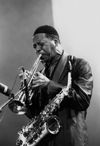
This Ornette Coleman track, 'Clergyman's Dream,' is taken from the 'Live at the Tivoli' session.
One of those jaunty, conversational themes of Ornette's, this vocal quality mirrored by the structure of call and response: the A section constructed from alternating slow phrases answered by in double time. Ornette weaves in and out of variations upon it, a crystal, airy, Ariel-like clarity to his playing as the rhythm settles into a firm medium tempo. A clear recording (originally a bootleg) from 1965, when free jazz was still relatively new – bouncing, spiralling as the bass and drums weave round him in an intricate dance. Unlike many records from this period (especially Coltrane's) the bass is very clear and really is the third angle on this group equilateral triangle. (The lack of piano may help...). Izenson takes an excellent bass solo, fast and strong-fingered picking, followed by Moffet. Some people hate drum solos – I've always liked them if they tell a reasonable story – from the free jazz era especially with the further loosening of pulses and rhythm, I find them intriguing. Moffett adds an extra timbre with a tambourine on his kit. A long solo – but rewarding – changes of dynamics and sonority add further interest. It demonstrates perfectly Ornette's overall conception: a freedom rooted in the blues and embedded more in the tradition than seemed to many at the time - the rhythm is not that far removed from the more conventional jazz of the sixties – less abstract, say, than Cecil Taylor's bands. By backing harmony down and upgrading melody and rhythm the opportunities for invention seem limitless. This is a long track – but I cannot see how this music could be reduced to short, sharp bursts. It needs the room to breathe, as if the old complex bebop line had been reinvented by stretching it out and focusing on its melodic potential, away from the recurring harmonic imperatives... which it had...
This clergyman was obviously some kind of ecclesiastical renegade in his dreams...
One for Anthony... who is a great fan of Ornette...
Ornette Coleman Trio
(Ornette Coleman: alto saxophone;David Izenson: bass; Charles Moffett: drums).
Clergyman's Dream
Download
Buy


8 comments:
What a lovely, rollicking tune - the archetypal Ornette folk-like piece of music. 1965? ... it could have been recorded yesterday - Life-affirming and uplifting, to run the risk of coming across all touchy feely.
Izenson and Moffett, you can really hear them here, an underrated rhythm section when it comes to Coleman's work.
Really good quality recording, too, and the audience sound like they're enjoying it, the lucky sods.
How anyone could ever think Coleman couldn't play is beyond me, I love his tone.
Nome-de-net homage - I like that.
This Ornette piece is played by probably my favourite jazz/improv line-up - horn, bass and drums. Most of the albums I love best spring from that structure - Ornette's , Albert Ayler's ... it just seems like a set-up that works, for me.
Maybe I'll put up some of the old Gerry Mulligan quartet stuff - with two horns and bass and drums - which I think anticipates some of this music. The concept is the same - when you get rid of the piano (or guitar) playing chords it frees up the whole band - takes you into different areas of potential. A lot of Coltrane's stuff has McCoy Tyner just doodling away -until he usually drops out and leaves Trane and the drummer to it. I think this was one of Ornette's great bands - there is a dancing quality to the music - springtime stuff where anything is possible...
I like piano when it's more or less the lead, Cecil taylor most obviously, but yes, sometimes it just gets in the way ... Tyner is a good example - the horn and rhythm section just seems to have more clarity.
I should add that I write as a sax player and players of any other instruments are fully entitled to tell me I don't know what I'm talking about.
I agree - Taylor's piano is so dense and polyrhythmic that the lines can go anywhere - they're not locked into 32 bar cycles and/or the usual chromatic ii v patterns. That gives the soloist many more directions - and he is also playing his own concept - he is the leader, as you say. But it's a complex trick to pull off.
Tyner is a great piano player and did sterling work with Coltrane - but as they plunged further into sonic space it seemed that he had difficulty in following his leader... Alice Coltrane was much better at playing on those later tracks
Much as I love the classic Coltrane quartet, Jones and Tyner become increasingly out of sympathy with Coltrane's direction ... I think Jones expressed a degree of antipathy towards Ali joining him on the drums.
Maybe, too, I should have described myself as a sax 'player', when involved in a discussion of such figures as Coltrane ...
Thanks for this. I love it when things get sparse and tinkery around the 7-minute mark.
Post a Comment